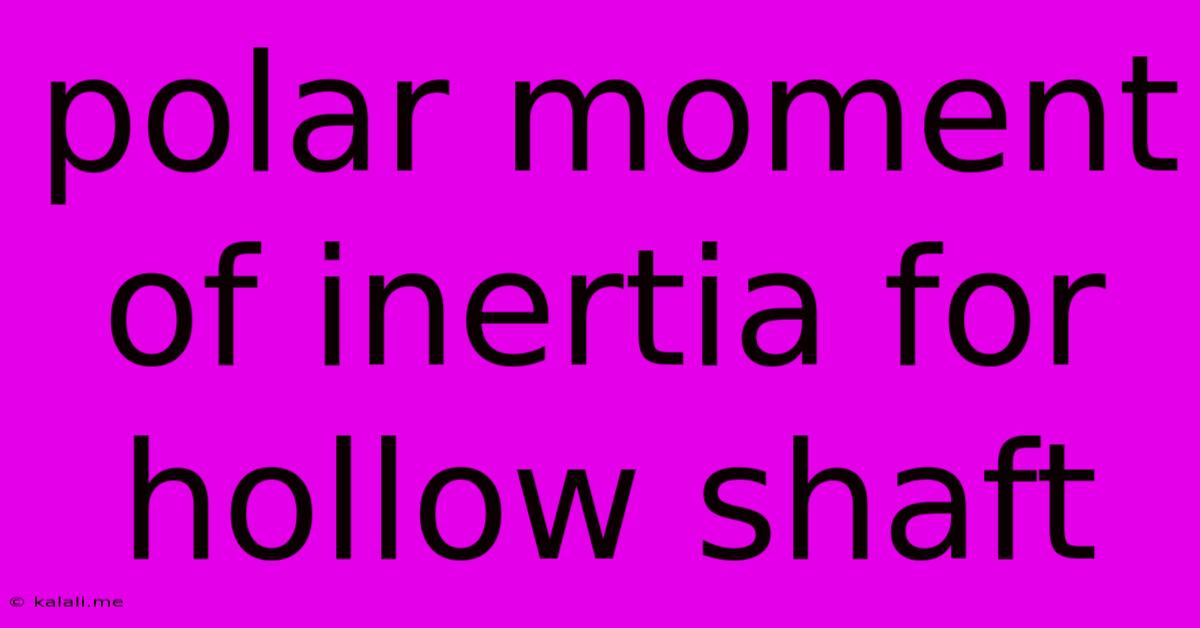Polar Moment Of Inertia For Hollow Shaft
Kalali
Jun 13, 2025 · 3 min read

Table of Contents
Polar Moment of Inertia for a Hollow Shaft: A Comprehensive Guide
The polar moment of inertia, often denoted as J or Ip, is a crucial concept in mechanical engineering, particularly when analyzing torsional stress and deflection in shafts. Understanding this property is essential for designing safe and efficient rotating components. This article delves into the polar moment of inertia specifically for hollow shafts, explaining its calculation, significance, and applications. This guide will provide you with the knowledge needed to accurately calculate and understand the importance of the polar moment of inertia for hollow shafts in various engineering applications.
What is the Polar Moment of Inertia?
The polar moment of inertia represents a body's resistance to torsional deformation. Imagine twisting a shaft; the higher the polar moment of inertia, the more resistant it will be to this twisting force. It's essentially a measure of how the mass is distributed relative to the axis of rotation. For a hollow shaft, this distribution is crucial because the material is concentrated in a ring, rather than a solid cylinder. This difference greatly affects the shaft's torsional rigidity.
Calculating the Polar Moment of Inertia for a Hollow Shaft
The formula for calculating the polar moment of inertia (J) of a hollow circular shaft is:
J = (π/32) * (Do⁴ - Di⁴)
Where:
- J is the polar moment of inertia
- Do is the outer diameter of the shaft
- Di is the inner diameter of the shaft
- π is pi (approximately 3.14159)
This formula highlights the significant impact of the inner diameter. A small change in the inner diameter can substantially affect the overall polar moment of inertia. This is because the material further from the central axis contributes more significantly to the resistance to torsion.
Significance of the Polar Moment of Inertia in Hollow Shafts
The polar moment of inertia is critical for several reasons in the context of hollow shafts:
-
Torsional Stress Calculation: The shear stress (τ) induced in a hollow shaft under torsion is directly related to the applied torque (T) and the polar moment of inertia (J): τ = (T * r) / J, where 'r' is the radial distance from the center. A larger J means lower stress for the same torque.
-
Angle of Twist Calculation: The angle of twist (θ) in a hollow shaft is also directly related to the applied torque, shaft length (L), shear modulus (G), and polar moment of inertia (J): θ = (T * L) / (G * J). Again, a larger J leads to a smaller angle of twist under the same torque.
-
Shaft Design Optimization: By carefully selecting the outer and inner diameters, engineers can optimize the polar moment of inertia to meet specific strength and stiffness requirements, minimizing weight while maintaining structural integrity.
Applications of Hollow Shafts with Optimized Polar Moment of Inertia
Hollow shafts are preferred in various applications due to their higher strength-to-weight ratio compared to solid shafts. This is particularly beneficial in applications where weight is a critical factor, such as:
- Aerospace Engineering: Lightweight yet strong shafts are essential for aircraft and spacecraft components.
- Automotive Industry: Drive shafts and axles often utilize hollow shafts to reduce weight and improve fuel efficiency.
- Machine Design: High-speed rotating machinery frequently employs hollow shafts to minimize inertia and improve responsiveness.
Conclusion
The polar moment of inertia is a fundamental parameter for understanding the torsional behavior of hollow shafts. Accurate calculation of J, using the formula provided, is essential for designing safe and efficient rotating components across various engineering disciplines. By optimizing the inner and outer diameters, engineers can effectively manage torsional stress and deflection, resulting in lightweight yet robust designs. Understanding this concept is crucial for anyone working with rotating machinery and structural analysis.
Latest Posts
Latest Posts
-
How Many Times Does 7 Go Into 100
Jun 14, 2025
-
The Measure Of Force Of Gravity On An Object
Jun 14, 2025
-
How Many Drops In 1 2 Teaspoon
Jun 14, 2025
-
How Many Electrons In F Subshell
Jun 14, 2025
-
What Is The Goal Of Communication
Jun 14, 2025
Related Post
Thank you for visiting our website which covers about Polar Moment Of Inertia For Hollow Shaft . We hope the information provided has been useful to you. Feel free to contact us if you have any questions or need further assistance. See you next time and don't miss to bookmark.